知识补充
笛卡尔坐标系
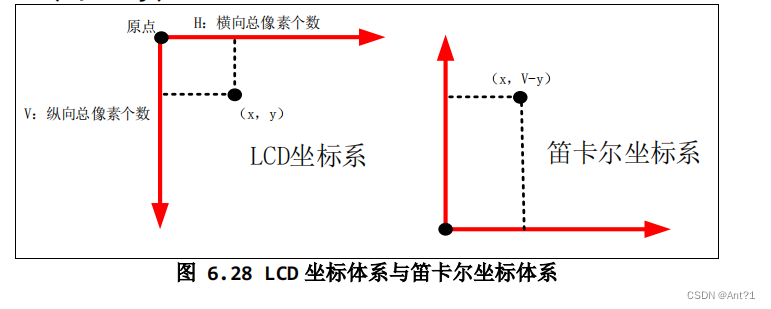
这里笛卡尔坐标系就是初高中学的直角坐标系的第一象限
lcd坐标系则不同
这两个坐标系如何转换
观察两个坐标系 点(x,y)的x坐标在两个坐标系中相同,纵坐标(y)存在着y+V-y=V V是整个屏幕的行数的像素点
如何将做到一行文字胖瘦不一
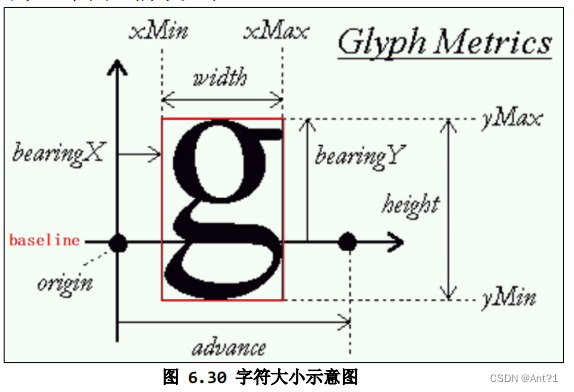
在显示一行文字时,这些文字会基于同一个基线来绘制位图:baseline(这个baseline不是最低点)。
在 baseline 上,每一个字符都有它的原点(origin),比如上图中 baseline
左边的黑色圆点就是字母“g”的原点。当前 origin 加上 advance 就可以得到
下一个字符的 origin,比如上图中 baseline 右边的黑色圆点。
在显示一行中多个文件字时,后一个文字的原点依赖于前一个文字的原点及 advance。
字符的位图是有可能越过 baseline 的,比如上图中字母“g”在 baseline
下方还有图像。
上图中红色方框内就是字母“g”所点据的位图,它的四个角落不一定与原点
重合。
上图中那些 xMin 、 xMax 、 yMin 、 yMax 如 何 获 得 ? 可 以 使 用
FT_Glyph_Get_CBox 函数获得一个字体的这些参数,将会保存在一个 FT_BBox结构体中,
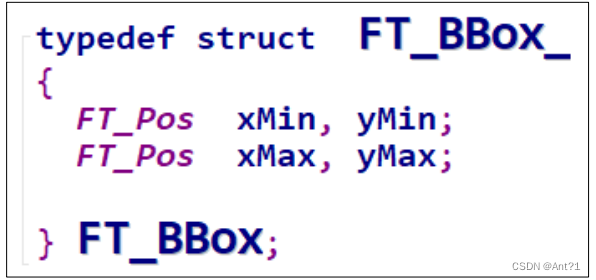
要显示一行文字时,每一个字符都有自己外框:xMin、xMax、yMin、yMax。
把这些字符的 xMin、yMin 中的最小值取出来,把这些字符的 xMax、yMax 中的
最大值取出来,就可以确定这行文字的外框了。
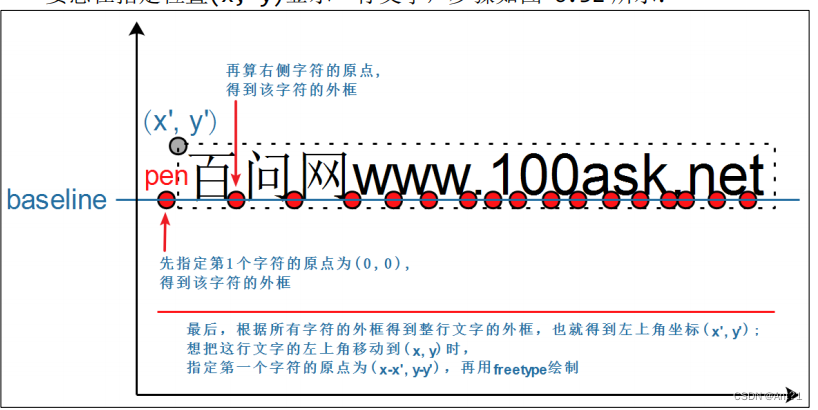
第1步 先指定第 1 个字符的原点 pen 坐标为(0, 0),计算出它的外框
第2步 再计算右边字符的原点,也计算出它的外框
把所有字符都处理完后就可以得到一行文字的整体外框:假设外框左上角坐
标为(x’, y’)。
第3步 想在(x, y)处显示这行文字,调整一下 pen 坐标即可。怎么调整?
pen 为(0, 0)时对应左上角(x’, y’);那么左上角为(x, y)时就可以算出pen 为(x-x’, y-y’)。
freetype 的几个重要数据结构
FT_Library
对应 freetype 库,使用 freetype 之前要先调用以下代码:
FT_Library library; /* 对应 freetype 库 /
error = FT_Init_FreeType( &library ); / 初始化 freetype 库 /
FT_Face
它对应一个矢量字体文件,在源码中使用 FT_New_Face 函数打开字体文件
后,就可以得到一个 face。
FT_GlyphSlot
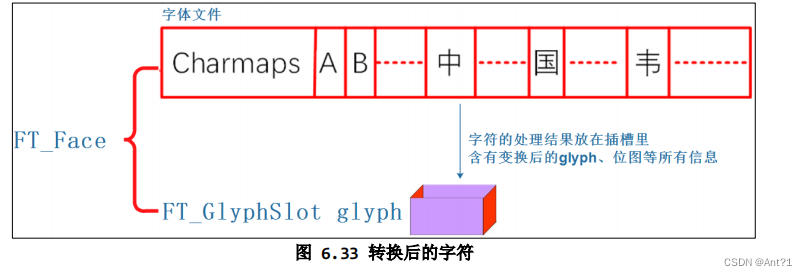
注意两点
glyph是face的一个成员
face->glyph会覆盖
一个 face 中有很多字符,生成一个字符的点阵位图时,位图保存在哪里?
保存在插槽中:face->glyph。
生成第 1 个字符位图时,它保存在 face->glyph 中;生成第 2 个字符位图
时,也会保存在 face->glyph 中,会覆盖第 1 个字符的位图。
FT_GlyphSlot slot = face->glyph; / 插槽: 字体的处理结果保存在这里 */
FT_Glyph
字体文件中保存有字符的原始关键点信息,使用 freetype 的函数可以放大、
缩小、旋转,这些新的关键点保存在插槽中(注意:位图也是保存在插槽中)。
新的关键点使用 FT_Glyph 来表示,可以使用这样的代码从 slot 中获得glyph:
error = FT_Get_Glyph(slot , &glyph);
#include <sys/mman.h>
#include <sys/types.h>
#include <sys/stat.h>
#include <unistd.h>
#include <linux/fb.h>
#include <fcntl.h>
#include <stdio.h>
#include <string.h>
#include <math.h>
#include <wchar.h>
#include <sys/ioctl.h>#include <ft2build.h>
#include FT_FREETYPE_H
#include FT_GLYPH_Hint fd_fb;
struct fb_var_screeninfo var; /* Current var */
struct fb_fix_screeninfo fix; /* Current fix */
int screen_size;
unsigned char *fbmem;
unsigned int line_width;
unsigned int pixel_width;/* color : 0x00RRGGBB */
void lcd_put_pixel(int x, int y, unsigned int color)
{unsigned char *pen_8 = fbmem+y*line_width+x*pixel_width;unsigned short *pen_16; unsigned int *pen_32; unsigned int red, green, blue; pen_16 = (unsigned short *)pen_8;pen_32 = (unsigned int *)pen_8;switch (var.bits_per_pixel){case 8:{*pen_8 = color;break;}case 16:{/* 565 */red = (color >> 16) & 0xff;green = (color >> 8) & 0xff;blue = (color >> 0) & 0xff;color = ((red >> 3) << 11) | ((green >> 2) << 5) | (blue >> 3);*pen_16 = color;break;}case 32:{*pen_32 = color;break;}default:{printf("can't surport %dbpp\n", var.bits_per_pixel);break;}}
}/*********************************************************************** 函数名称: draw_bitmap* 功能描述: 根据bitmap位图,在LCD指定位置显示汉字* 输入参数: x坐标,y坐标,位图指针* 输出参数: 无* 返 回 值: 无* 修改日期 版本号 修改人 修改内容* -----------------------------------------------* 2020/05/12 V1.0 zh(angenao) 创建***********************************************************************/
void
draw_bitmap( FT_Bitmap* bitmap,FT_Int x,FT_Int y)
{FT_Int i, j, p, q;FT_Int x_max = x + bitmap->width;FT_Int y_max = y + bitmap->rows;//printf("x = %d, y = %d\n", x, y);for ( j = y, q = 0; j < y_max; j++, q++ ){for ( i = x, p = 0; i < x_max; i++, p++ ){if ( i < 0 || j < 0 ||i >= var.xres || j >= var.yres )continue;//image[j][i] |= bitmap->buffer[q * bitmap->width + p];lcd_put_pixel(i, j, bitmap->buffer[q * bitmap->width + p]);}}
}int compute_string_bbox(FT_Face face, wchar_t *wstr, FT_BBox *abbox)
{int i;int error;FT_BBox bbox;FT_BBox glyph_bbox;FT_Vector pen;FT_Glyph glyph;FT_GlyphSlot slot = face->glyph;/* 初始化 */bbox.xMin = bbox.yMin = 32000;bbox.xMax = bbox.yMax = -32000;/* 指定原点为(0, 0) */pen.x = 0;pen.y = 0;/* 计算每个字符的bounding box *//* 先translate, 再load char, 就可以得到它的外框了 *//* wcslen是一个C库函数,用于计算宽字符字符串的长度(以宽字符的数量为单位),即获取宽字符字符串中的字符数(不包括终止空字符L'\0')。 */for (i = 0; i < wcslen(wstr); i++){/* 转换:transformation *//* FT_Set_Transform是FreeType库中用于设置字形变换矩阵的函数。获得这个字符的原点*/FT_Set_Transform(face, 0, &pen);/* 加载位图: load glyph image into the slot (erase previous one) */error = FT_Load_Char(face, wstr[i], FT_LOAD_RENDER);if (error){printf("FT_Load_Char error\n");return -1;}/* 取出glyph */error = FT_Get_Glyph(face->glyph, &glyph);if (error){printf("FT_Get_Glyph error!\n");return -1;}/* 从glyph得到外框: bbox */FT_Glyph_Get_CBox(glyph, FT_GLYPH_BBOX_TRUNCATE, &glyph_bbox);/* 更新外框 */if ( glyph_bbox.xMin < bbox.xMin )bbox.xMin = glyph_bbox.xMin;if ( glyph_bbox.yMin < bbox.yMin )bbox.yMin = glyph_bbox.yMin;if ( glyph_bbox.xMax > bbox.xMax )bbox.xMax = glyph_bbox.xMax;if ( glyph_bbox.yMax > bbox.yMax )bbox.yMax = glyph_bbox.yMax;/* 计算下一个字符的原点: increment pen position */pen.x += slot->advance.x;pen.y += slot->advance.y;}/* return string bbox */*abbox = bbox;
}/* face:生成的矢量字体文件wstr 要显示的文字字符串地址x 文字显示位置横坐标y 文字显示位置纵坐标*/
int display_string(FT_Face face, wchar_t *wstr, int lcd_x, int lcd_y)
{int i;int error;FT_BBox bbox;FT_Vector pen;FT_Glyph glyph;FT_GlyphSlot slot = face->glyph;/* 把LCD坐标转换为笛卡尔坐标 */int x = lcd_x;int y = var.yres - lcd_y;/* 计算外框 */compute_string_bbox(face, wstr, &bbox);/* 左上角反推原点 */pen.x = (x - bbox.xMin) * 64; /* 单位: 1/64像素 */pen.y = (y - bbox.yMax) * 64; /* 单位: 1/64像素 *//* 处理每个字符 */for (i = 0; i < wcslen(wstr); i++){/* 转换:transformation */FT_Set_Transform(face, 0, &pen);/* 加载位图: load glyph image into the slot (erase previous one) */error = FT_Load_Char(face, wstr[i], FT_LOAD_RENDER);if (error){printf("FT_Load_Char error\n");return -1;}/* 在LCD上绘制: 使用LCD坐标 */draw_bitmap( &slot->bitmap,slot->bitmap_left,var.yres - slot->bitmap_top);/* 计算下一个字符的原点: increment pen position */pen.x += slot->advance.x;pen.y += slot->advance.y;}return 0;
}int main(int argc, char **argv)
{ //1、字符处理以Unicode类型wchar_t *wstr = L"坚持学习Linux";FT_Library library;FT_Face face;int error;FT_BBox bbox;int font_size = 24;int lcd_x, lcd_y;if (argc < 4){printf("Usage : %s <font_file> <lcd_x> <lcd_y> [font_size]\n", argv[0]);return -1;}//2、获取显示位置 将str to ullcd_x = strtoul(argv[2], NULL, 0); lcd_y = strtoul(argv[3], NULL, 0); if (argc == 5)//3、获取字体大小font_size = strtoul(argv[4], NULL, 0); //4、以O_RDWR打开/dev/fb0驱动文件fd_fb = open("/dev/fb0", O_RDWR);if (fd_fb < 0){printf("can't open /dev/fb0\n");return -1;}/* 5、A 获取lcd信息 这获得的是可变参数*/if (ioctl(fd_fb, FBIOGET_VSCREENINFO, &var)){printf("can't get var\n");return -1;}/* 5、B 获取lcd信息 这获得的是固定参数*/if (ioctl(fd_fb, FBIOGET_FSCREENINFO, &fix)){printf("can't get fix\n");return -1;}/* 6、计算屏幕宽度,屏幕尺寸,像素的bpp以字节为单位 */line_width = var.xres * var.bits_per_pixel / 8;pixel_width = var.bits_per_pixel / 8;screen_size = var.xres * var.yres * var.bits_per_pixel / 8;/* 7、映射framebuffer */fbmem = (unsigned char *)mmap(NULL , screen_size, PROT_READ | PROT_WRITE, MAP_SHARED, fd_fb, 0);if (fbmem == (unsigned char *)-1){printf("can't mmap\n");return -1;}/* 清屏: 全部设为黑色 */memset(fbmem, 0, screen_size);/* 8、初始化 FreeType库*/error = FT_Init_FreeType( &library ); /* initialize library *//* 9、根据字体库得到face对应一个矢量字体文件 */error = FT_New_Face( library, argv[1], 0, &face ); /* create face object *//* 10、设置字体大小 */FT_Set_Pixel_Sizes(face, font_size, 0);/* 11、打印到lcd*/display_string(face, wstr, lcd_x, lcd_y);return 0;
}







】)


介绍)


:基于Q-learning的无人机物流路径规划研究(提供Python代码))



)
